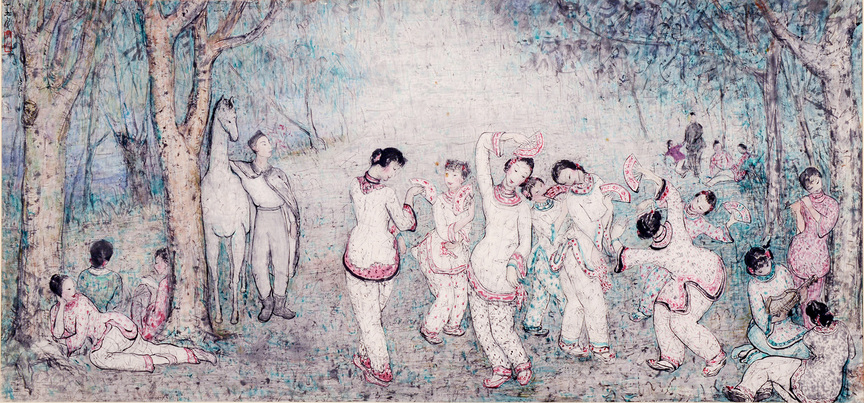-
From Current Issue
-
- Editor’s Letter Fire in the Heart
- Reviews I Gusti Ayu Kadek Murniasih
- Reviews 11th Seoul Mediacity Biennale: “One Escape at a Time”
- Dispatch Networked China
- One on One Monira Al Qadiri on Yukio Mishima
- Essays The rise of independent art spaces in pandemic-era Shanghai
- Features Tuan Andrew Nguyen
- Table of Contents
- Web Exclusives
- Archive
- Subscribe

R
E
V N
E
X
T
Installation view of PAN YU-LIN’s (foreground) A Woman Combing Her Hair, 1963, ink and color on paper, 90 × 64 cm, at “Song of Spring: Pan Yu-Lin in Paris,” Asia Society Hong Kong, 2018. All images courtesy Asia Society Hong Kong.
In conversations about Chinese women artists of the 20th century, Pan Yu-Lin is a name that invariably crops up. She was in the first cohort of female graduates from the Shanghai Art Academy, and later traveled to France and Italy for further training during the 1920s. Yet, although a respected artist and educator, outside of artistic circles, her artworks tested the limits of social and cultural acceptability in China, while in Europe, she struggled to be seen beyond the lens of Orientalism. At Asia Society’s “Song of Spring: Pan Yu-Lin in Paris,” one could see how the artist continuously sought to strike a balance between Western and Eastern styles of representation, which would allow her to authentically portray her experience as a Chinese woman abroad.
It is easy to dismiss Pan’s early oil paintings, presented in the first section of the exhibition, as derivative of Fauvism, Post-Impressionism, and all the -isms that she would have come across in France. Sweet Dream (1940) harkens back to the motif of the reclining nude—a tradition that became increasingly distasteful towards the turn of the century, when Western primitivists began to draw inspiration from the colonies, one-upping each other in the degrading ways that they could depict their exotic subjects. Consider Gauguin’s 1892 Spirit of the Dead Watching, where the “primitive” girl is depicted with an utter disregard for the modesty that would have been expected of a Western woman, followed by Matisse’s Blue Nude in 1907, where he exaggerates the figure’s sexuality to the point of monstrosity. Pan’s Sweet Dream shows a Chinese woman in the bold, orangey hues of the Fauves, in a similar position as the African subject of Matisse’s Blue Nude. The female figure is submissive as ever, with her eyes shut, and open body language. The bed tilts in a way so it appears that, at any moment, she may slide into the viewer’s space. There is one shocking element: her underarm hair remains untrimmed, going against the ideal of a woman with no “objectionable” body hair. Therein lies a hint of the direction that Pan would take with her later ink and color works, where she begins to explore the female form as it is, casting off the traditions and expectations built by the male gaze.
In her ink and watercolor pieces, Pan abandons the ground line, opting for a more traditionally Chinese approach to depicting space. In Singing and Dancing (1956), the green of the grass extends all the way to the sky, giving the impression of unending foliage. As for Women Peeping at the Window, Pan sidesteps the issue of omitting a ground line within an enclosed space by having the beige curtain blend seamlessly with the carpet of the same color. Although the full-figured women that now dominate the canvases are derived from the life drawing of Western art, they deviate from the norm in that they are not the soft, rounded figures that one would expect to find in a Titian or an Ingres. Stark, angular lines render their forms naturalistic, giving them more realistic musculature, and moreover trace back to the strong black lines in Eastern calligraphy. This is most evident in Hoping for Peace (1952), where the ponytail of the subject is delineated with a single swoop of a thick brush. These are women who truly occupy space, who interact with one another, and exist for a purpose beyond providing for male consumption. While we look at the picture frame, they peer out the window. Thus by denying access to their faces, Pan reverses the roles between the viewer and the subject, and essentially nullifies the whole point of the female nude.
It may be disappointing that her earlier nude portraits still play into the Western trope of the exotic Other, but in the context of the art scenes at the time—in China as in the West—a woman artist drawing nude figures would have been almost completely unheard of. Her oil paintings in themselves are not without merit either. A noteworthy one would be Self-Portrait in Red (circa 1940), where, gazing steadily forward, Pan quietly asserts her identity as an artist. The signature can be found on the letter in her hand, addressed to her name in Chinese.
“Song of Spring: Pan Yu-Lin in Paris” is on view at Asia Society, Hong Kong, until January 6, 2019.
To read more of ArtAsiaPacific’s articles, visit our Digital Library.














